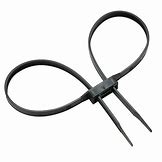PlastiCuffs
PlastiCuffs (also called FlexiCuffs) are a form of physical restraint for the hands, using plastic straps. They effectively play the same role as handcuffs, except that they are cheaper, easier to carry, and cannot be reused. The traditional form of PlastiCuffs are cable ties, either two interlocking straps, or a single cable tie around both wrists. More recently, plastics-manufacturing companies have started to produce special plasticuff devices, comprising two interconnected straps as one item. These are generally injection molded nylon items, selling for tens of cents each.
Disposable restraints have the following advantages and disadvantages:
Advantages:
- Lack of disease transmission.
- Low per-unit cost.
- Cannot be "picked" unless the cuffed has knowledge of how to do so.
Disadvantages:
- Only useful on compliant subjects; unworkably difficult to apply to a resistive or combative subject.
- Cannot be double-locked (leaving open the risk of paralyzing the subject's hands).
- A subject of great physical strength (deriving from physique and/or chemical influence) may be able to break free with enough effort.
- Cannot be reused; greater long-term cost compared to metal handcuffs.
- Much easier to cut or melt than metal cuffs. Light-duty wire cutters or a cigarette lighter will make short work of nylon cuffs.
A major advantage of disposable restraints is their lack of disease transmission; whereas metal handcuffs can spread disease through reuse (for example, from bloodstains or other bodily fluids that may not have been cleaned off the cuffs), a single set of disposable restraints are not used on multiple subjects.
Plasticuffs are more uncomfortable than handcuffs for the person being restrained, especially if they are not applied correctly. More care and training are required for the person applying them in order to avoid making them too tight. With some models, it is possible to apply them so tightly as to restrict blood flow to the hands, potentially causing localized paralysis to the subject. Another risk of disposable restraints is that a subject of great physical strength may be able to break free from them with enough effort.
The low cost and light weight of PlastiCuffs has made them popular with riot police, for use in demonstrations where they anticipate a large number of arrests. They have the advantage of requiring large cutters to remove (easily detected on a person), compared to regular handcuffs where keys can easily be concealed.
Both cable ties and PlastiCuffs are also in regular use by the military, where again their light weight is an advantage. They can be seen in many images of POWs or civilians designated as enemy combatants (for example, the Abu Ghraib prisoner abuse pictures).
Various innovations on the PlastiCuff theme have been developed, including:
- Plasticuffs which can be released using a regular handcuff key
- Extremely lightweight restraints made from nylon cord, using a plastic device to hold the cord tight
- Use of various designs with softer and more flexible straps
Chat rooms • What links here • Copyright info • Contact information • Category:Root
